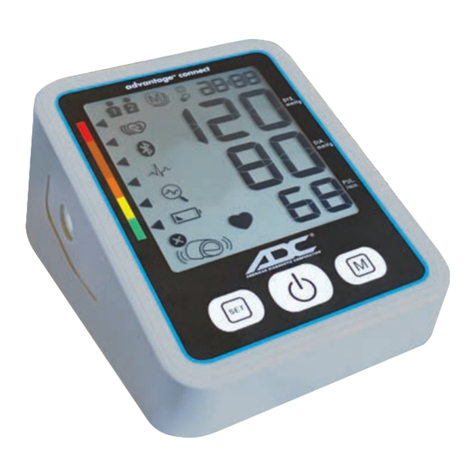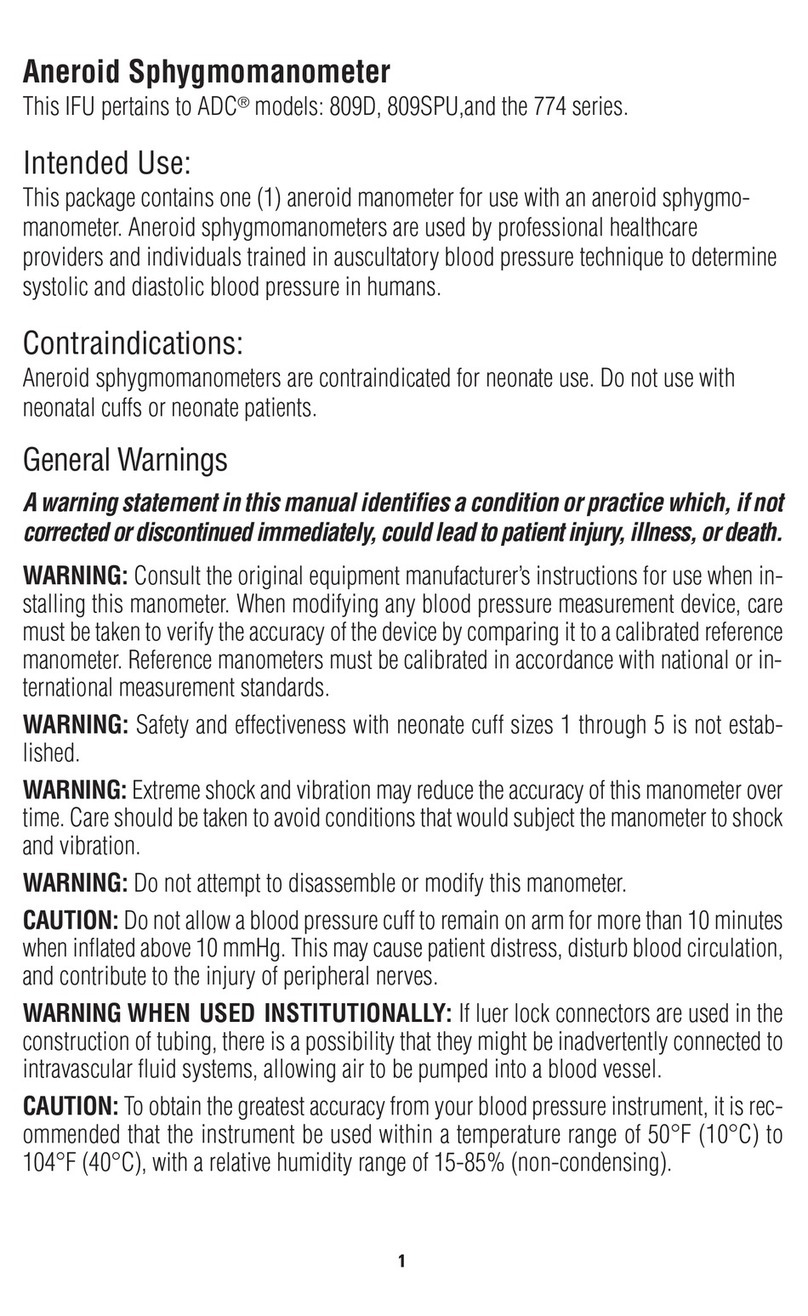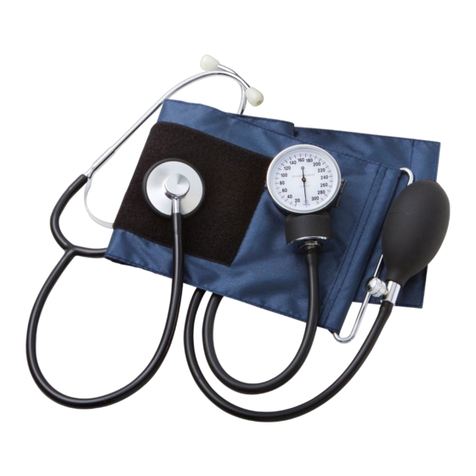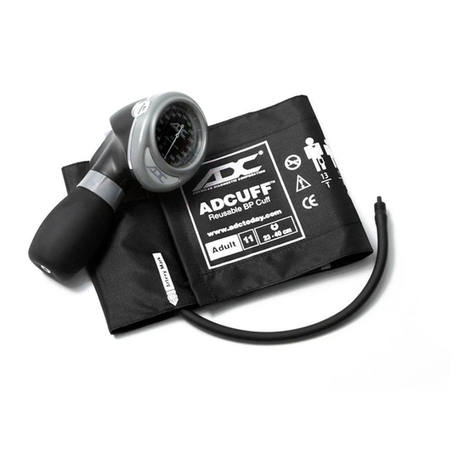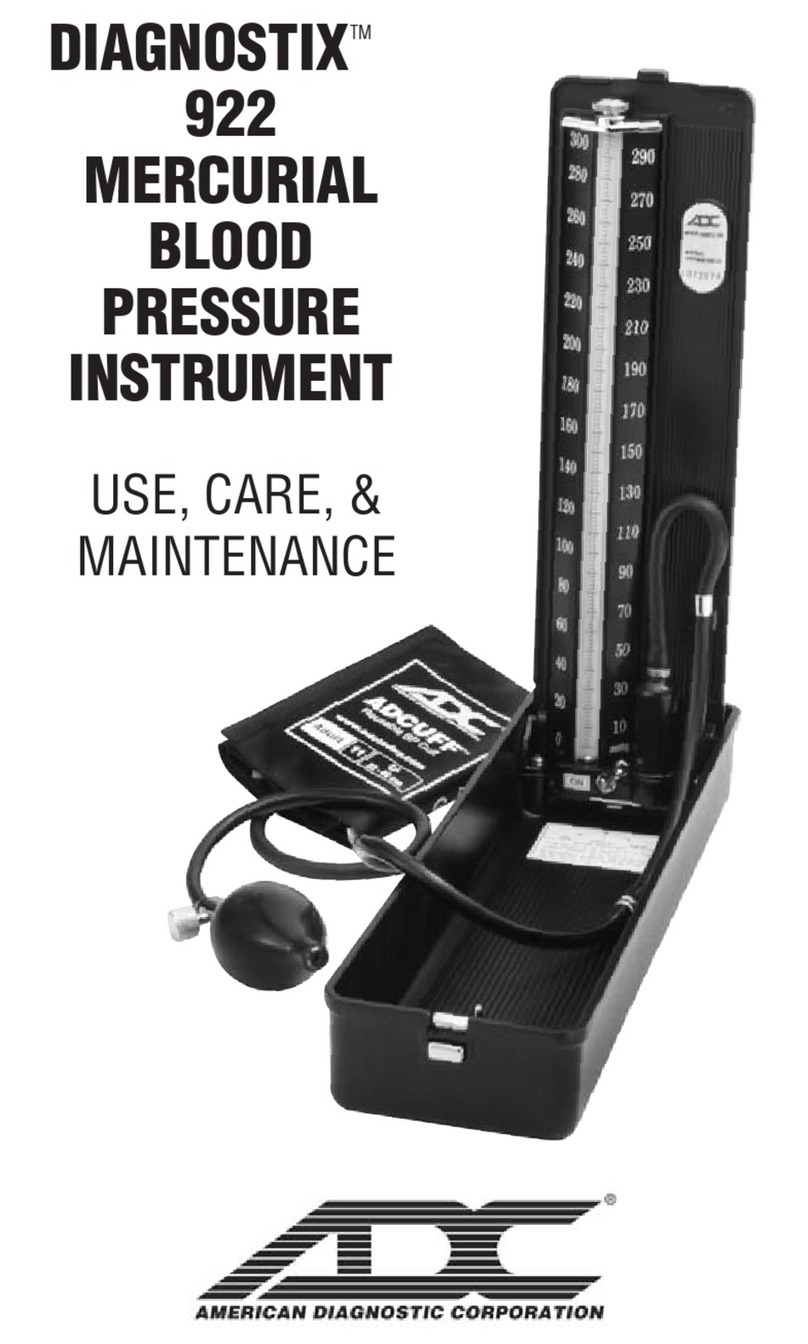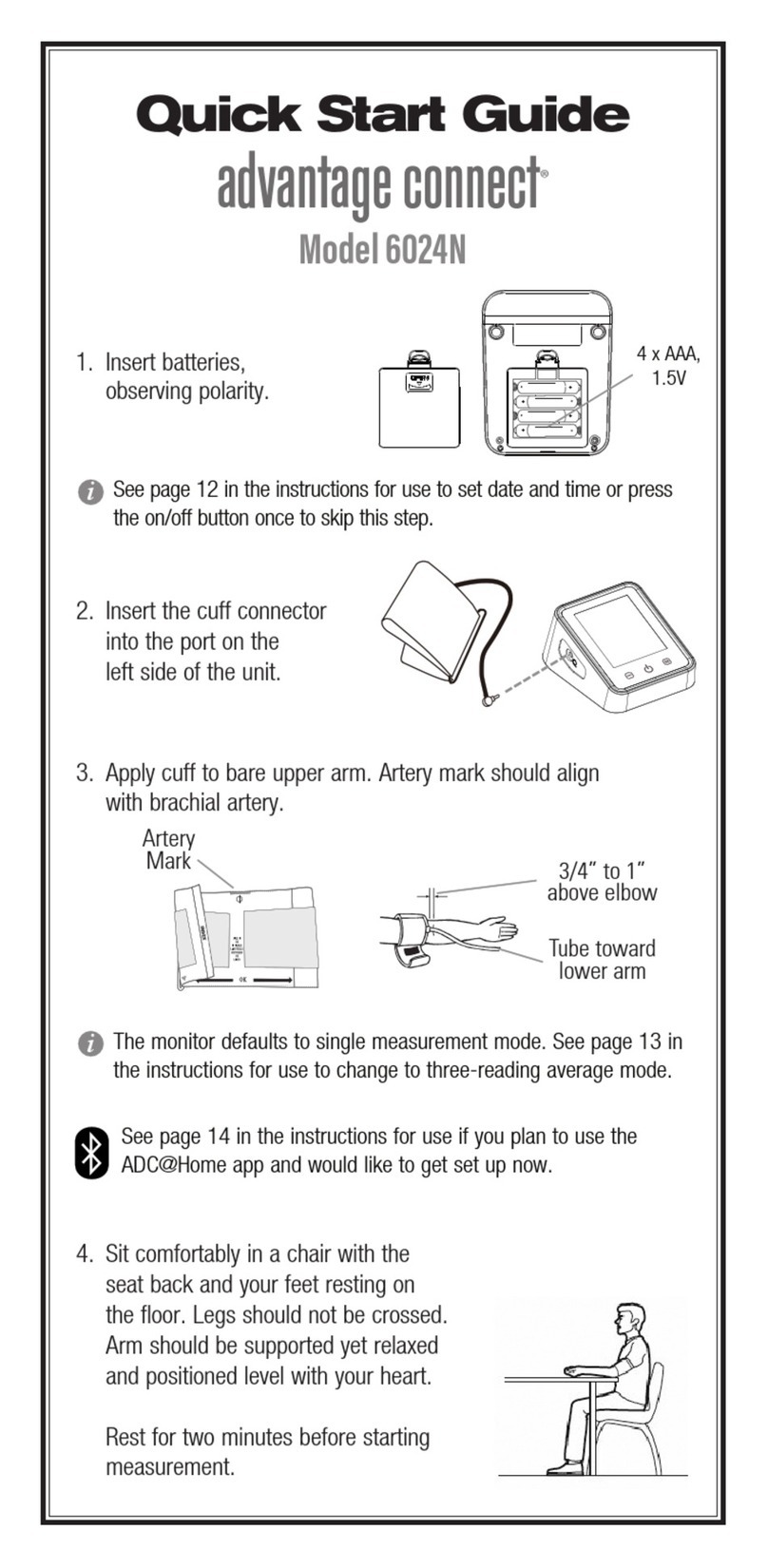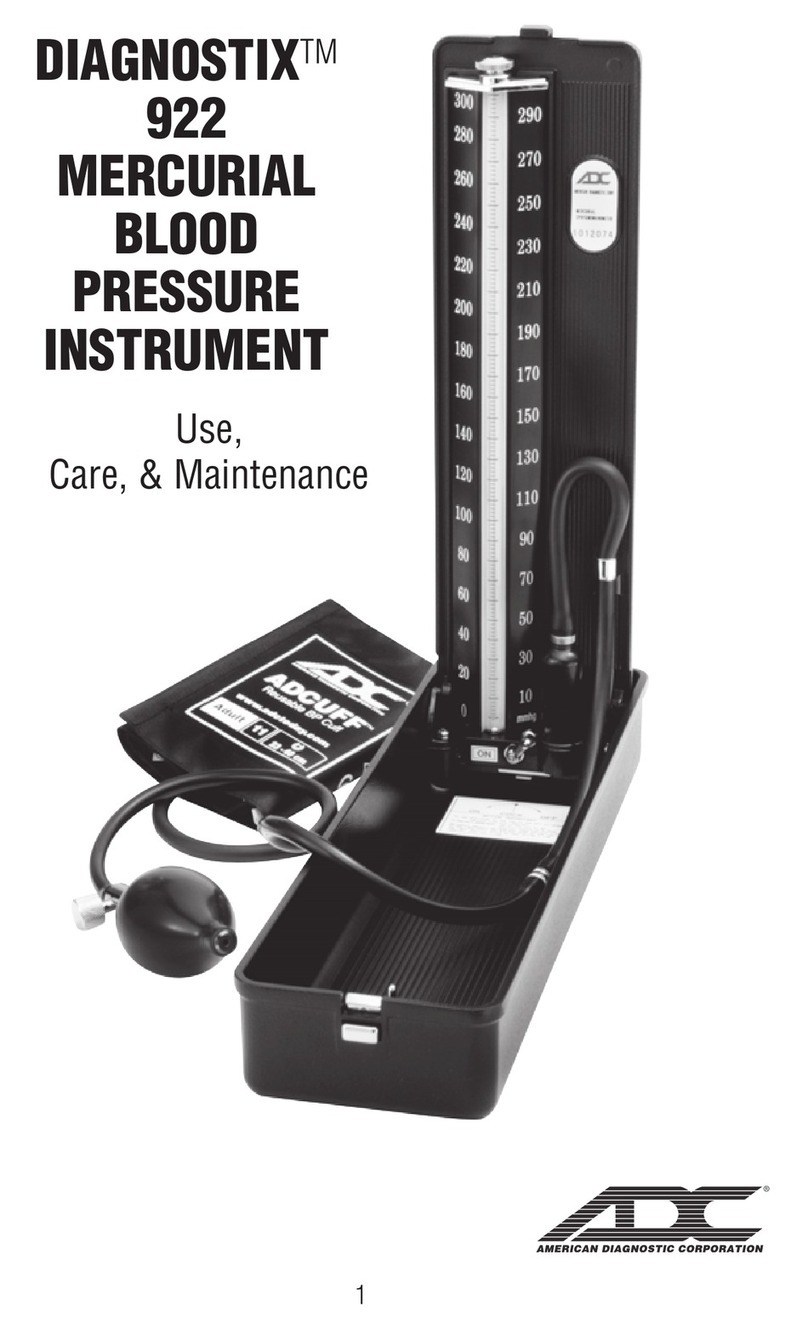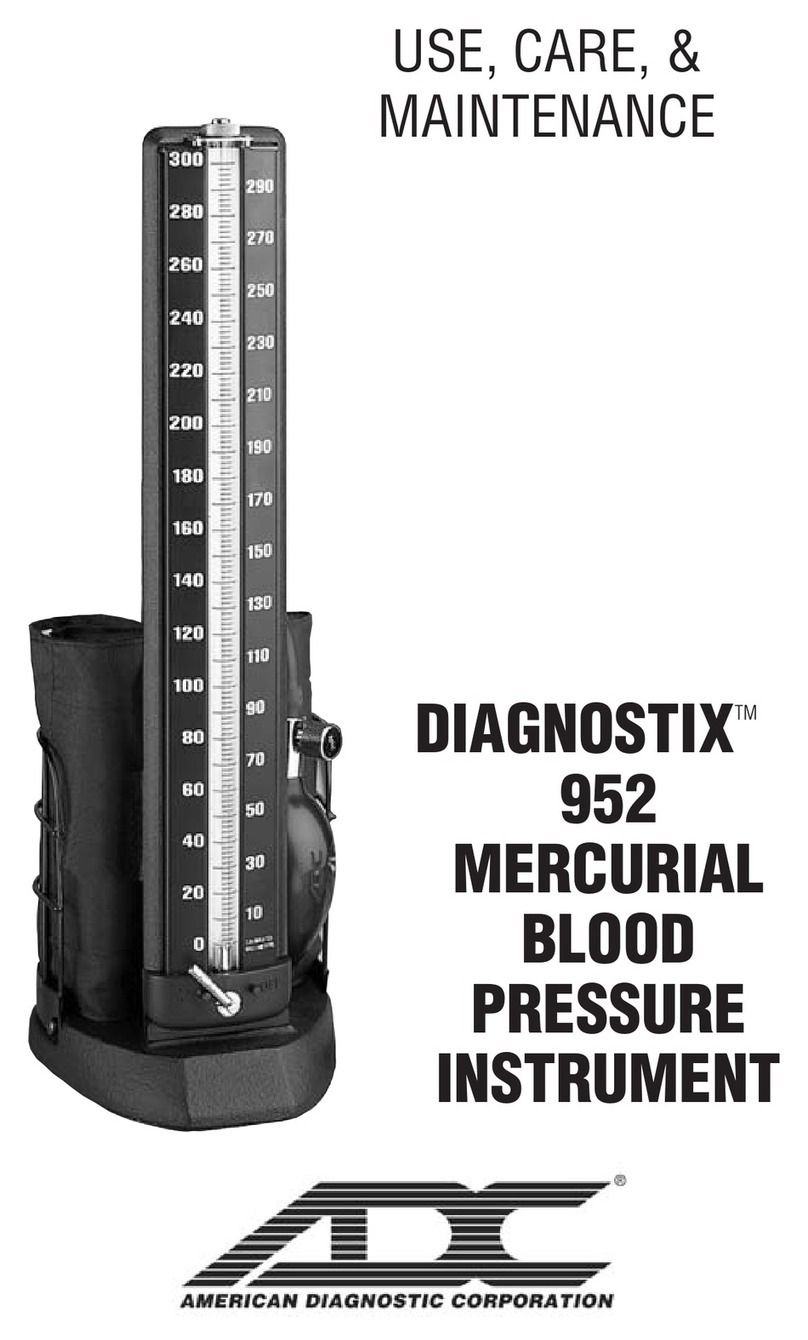Cuff
Coiled Tubing
Bulb
Valve
Manometer
ADC Aneroid Sphygmomanometer
(manometer, cuff, bladder, bulb and valve)
Thank you for choosing an ADC Diagnostix Aneroid Sphygmomanometer. Your new
aneroid is designed to provide unrivaled durability and unparalleled comfort. Every
component has been carefully designed to maximize performance. This Instructions
for Use guide refers to ADC model series 700, 703, 705, 720, 728, 731, 732, 740,
750, 752, 778, and 788.
Device Description and Intended Use
ADC aneroid sphygmomanometers are used by professional healthcare providers and
individuals trained in the auscultatory blood pressure technique to determine systolic
and diastolic blood pressure in humans.
Contraindications:
Aneroid sphygmomanometers
are contraindicated for neonate use.
Do not use with neonatal cuffs or
neonate patients. Review the size
chart for proper age and limb range
usage (right).
Symbol Definitions
The following symbols are associated with your ADCDiagnostix Aneroid
General Warnings
A warning statement in this manual identifies a condition or practice
which, if not corrected or discontinued immediately, could lead to patient
injury, illness, or death.
WARNING:
Do not allow a blood pressure cuff to remain on patient for more
than 10 minutes when inflated above 10 mmHg. This may cause patient distress,
disturb blood circulation, and contribute to the injury of peripheral nerves.
WARNING:
If luer lock connectors are used in the construction of tubing,
there is a possibility that they might be inadvertently connected to intra-vascular
fluid systems, allowing air to be pumped into a blood vessel. Immediately consult a
physician if this occurs.
WARNING: Safety and effectiveness with neonate cuff sizes 1 through 5 is
not established.
WARNING: If this equipment is modified, appropriate inspection and testing
must be conducted to ensure its continued safe use.
WARNING: Do not apply cuff to delicate or damaged skin. Check cuff site
frequently for irritation.
WARNING: Only use the cuff when the range markings indicated on the cuff
show that the proper cuff size is selected, otherwise erroneous readings
may result.
WARNING: Allow space between patient and cuff. Two fingers should fit in
this space if the cuff is correctly positioned.
WARNING: Do not apply cuff to limbs used for IV infusion.
WARNING: Patient should remain still during measurement to avoid
erroneous readings.
WARNING: When using with an infant or child cuff, extra care must be taken to
prevent over-inflation. With smaller cuffs (infant or child) the cuff can inflate to
over 300mmHg with just two full compressions of the bulb. To prevent discomfort
or injury to the patient and damage to the instrument, bulb should only be partially
squeezed, so that each “stroke” inflates the cuff in 40mmHg to 60mmHg increments
until inflated to the desired level.
CAUTION:
To obtain the greatest accuracy from your blood pressure instrument,
it is recommended that the instrument be used within a temperature range of
50°F (10°C) to 104°F (40°C), with a relative humidity range of 15%-85%
(non-condensing).
CAUTION: Extreme altitudes may affect blood pressure readings. Your device
has been designed for normal environmental conditions.
Operation of Diagnostix Pocket Aneroids
This booklet contains operating and
maintenance information for the
Diagnostix 700, 720, 728, and 778
Series pocket aneroid sphygmo-
manometers. Please read and retain.
Your Diagnostix brand pocket
aneroid sphygmomanometer
consists of an aneroid manometer
(gauge), complete inflation system
(Adcuff calibrated nylon cuff, latex-
free inflation bladder, squeeze bulb,
and Adflow valve), a zippered carry-
ing case, and operating instructions.
Most models are preassembled and ready for use. In units requiring assembly, the
bulb and valve should connect to the tube closest to the Index ine. The gauge con-
nects to the remaining tube.
Operation of Diagnostix
Palm Aneroids
This booklet contains operating and
maintenance information for the
Diagnostix 703 Series, 788 Series,
System 3, Pediatric, General Practice,
System 4, and System 5 Multicuff
instruments. Please read and retain.
Cuff
Index Line
Hang Tab Gauge
Artery Mark
Bulb & Valve
Bladder &
Tubing
Your Diagnostix palm-style aneroid manometer with integral bulb and trigger air release
valve (#804N), Adcuff calibrated cuff with Size Guide™marking system, bladder, bayonet-
style connector (attached to bladder tubing), zippered carrying case, and instruction book-
let. ADC’s Multicuff Systems (System 3, 4, 5, GPK, and PMK) contain the #804N manome-
ter and a variety of cuffs with single tube bladders, each equipped with a bayonet-style
connector, and a compartmentalized case.
Connecting Palm Style Model: 804
Legacy Connector: Assemble the supplied luer slip
connector into the connector port on top of palm gauge,
rubber gasket side down. Make sure connector is fully
seated in the connector port. Slide cuff tubing over the
barbed end of the connector. Connector will friction fit onto
the tubing of most commercially available ONE-tube cuff
and bladder systems (Figure 1).
New 804N Connector: Insert white bayonet connector
into metal receiver until it clicks (Figure 2).
To Release: Slide receiver collar downward toward gauge
until connector releases.
WARNING: Do NOT remove metal receiver from gauge.
WARNING: The palm style manometer is designed
for use with ONE-tube systems.
WARNING: To avoid damage to the instrument, do not force
connector into port.
Using the Trigger Valve
Deflat on: Gently squeeze the bottom of the trigger to deflate the cuff.
Altering the pressure affects the deflation rate.
Rap d Exhaust: To exhaust remaining air after measurement is
completed, squeeze trigger until it clicks and locks in place.
Caution: Never force trigger.
Operation of Diagnostix Clock Aneroids
This booklet contains operating and maintenance information
for the Diagnostix 750W series (wall mount), 752M series
(mobile), and 750D series (desktop) aneroid
sphygmomanometers. Please read and retain.
Your Diagnostix 750/752 consists of a large
“clockface” aneroid with easy-to-read 6” dial, an
integral swivel bracket/cuff storage compartment
(wall series only), complete inflation system
(which includes the Adcuff nylon cuff with Size
Guide marking system, latex-free inflation
bladder, bulb, and Adflow valve), 8-foot length coiled tubing,
luer connectors, mounting hardware, and operating instructions. The Diagnostix 752M is
mounted on a height adjustable, Spider- eg™5-leg mobile stand. The Diagnostix 750D is
mounted on a desktop stand.
To assemble the inflation system, connect coiled tubing to air inlet nipple at bottom of gauge.
Insert male luer adapter on bladder tubing into female receptacle at free end of coiled tubing.
Store folded inflation system in swivel bracket behind gauge on 750W and 750D or in integral
basket on 752M.
Adcuff Intended Use:
ADC blood pressure cuffs are noninvasive and are intended for use with manual and
automated noninvasive blood pressure measurement devices.
ADC’s Size Guide marking system assures use of correct cuff size and proper cuff
alignment. Printed Index and Range markings and applicable limb range (in cm)
allow easy identification of the correct cuff size. An artery mark printed on both sides
indicates bladder midpoint for correct cuff positioning. A convenient nylon gauge
hang tab permits flexible use with either pocket aneroids or mercury manometers.
Hook-and-loop adhesive surface provides a snug, infinitely variable fit and is
designed to withstand a minimum of 30,000 open/close cycles.
Measurement Procedure
Pat ent Pos t on
The patient should sit or lie comfortably. The arm should be fully supported on a
flat surface at heart level. (If the arm’s position varies, or is not level with the heart,
measurement values obtained will not be consistent with the patient’s true blood
pressure.) When seated, the patient should have their back and arm supported, and
their legs should not be crossed. Prior to measurement the patient should relax
comfortably for five minutes and should refrain from talking or moving during
measurement. Observer should view manometer in a direct line to avoid “parallax error.”
Apply the cuff
Adcuff nylon cuffs are specially designed
to promote the precisely accurate determi-
nation of blood pressure. Index and range
markings ensure use of the
correct cuff size. The artery mark
indicates proper cuff positioning.
Place the cuff over the bare upper arm with the artery mark positioned directly over
the brachial artery. The bottom edge of the cuff should be positioned approximately
one inch (2-3cm) above the antecubital fold. Wrap the end of the cuff not containing
the bladder around the arm snugly and smoothly and engage adhesive strips (Figure 3).
To verify a correct fit, check that the Index ine falls between the two Range ines
(Figure 4).
Left Arm
Tube
(Figure 3)
Cuff S ze Lmb Range
Inches CM
Infant 7I 3.5 to 5.5 9 to 14
Ch ld 9C 5.1 to 7.6 13 to 19.5
Sm. Adult 10SA 7.4 to 10.6 19 to 27
Adult 11A 9 to 15.7 23 to 40
Lg. Adult 12X 13.3 to 19.6 34 to 50
Th gh 13T 15.7 to 25.9 40 to 66
Bar atr c 12BX 17.3 to 25.9 44 to 66
Size Chart
